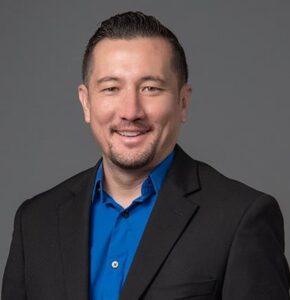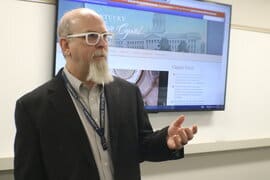
Data Modeling Zone (DMZ) returned to Phoenix March 4-6, 2025. It was amazing! Our next DMZ will be announced shortly!
Applications deliver value only when the underlying applications meets user needs. Yet organizations spend millions of dollars and thousands of hours every year developing solutions that fail to deliver. There is so much waste due to poorly capturing and articulating business requirements. Data models prevent this waste by capturing business terminology and needs in a precise form and at varying levels of detail, ensuring fluid communication across business and IT. Data modeling is therefore an essential skill for anyone involved in building an application: from data scientists and business analysts to software developers and database administrators. Data modeling is all about understanding the data used within our operational and analytics processes, documenting this knowledge in a precise form called the “data model”, and then validating this knowledge through communication with both business and IT stakeholders.
DMZ is the only conference completely dedicated to data modeling. DMZ US 2025 will contain five tracks:
DataOps, GitOps, and Docker containers are changing the role of Data Modeling, now at the center of end-to-end metadata management.
Success in the world of self-services analytics, data meshes, as well as micro-services and event-driven architectures can be challenged by the need to maintain interoperability of data catalogs/dictionaries with the constant evolution of schemas for databases and data exchanges.
In other words, the business side of human-readable metadata management must be up-to-date and in-sync with the technical side of machine-readable schemas. This process can only work at scale if it is automated.
It is hard enough for IT departments to keep in-sync schemas across the various technologies involved in data pipelines. For data to be useful, the business users must have an up-to-date view of the structures, complete with context and meaning.
In this session, we will review the options available to create the foundations for a data management framework providing architectural lineage and curation of metadata management.
Assuming no prior knowledge of data modeling, we start off with an exercise that will illustrate why data models are essential to understanding business processes and business requirements. Next, we will explain data modeling concepts and terminology, and provide you with a set of questions you can ask to quickly and precisely identify entities (including both weak and strong entities), data elements (including keys), and relationships (including subtyping). We will discuss the three different levels of modeling (conceptual, logical, and physical), and for each explain both relational and dimensional mindsets.

Steve Hoberman’s first word was “data”. He has been a data modeler for over 30 years, and thousands of business and data professionals have completed his Data Modeling Master Class. Steve is the author of 11 books on data modeling, including The Align > Refine > Design Series and Data Modeling Made Simple. Steve is also the author of Blockchainopoly. One of Steve’s frequent data modeling consulting assignments is to review data models using his Data Model Scorecard® technique. He is the founder of the Design Challenges group, creator of the Data Modeling Institute’s Data Modeling Certification exam, Conference Chair of the Data Modeling Zone conferences, director of Technics Publications, lecturer at Columbia University, and recipient of the Data Administration Management Association (DAMA) International Professional Achievement Award.
The regular organizer of your corporation’s employee social events, such as picnics and other gatherings, faces the challenge of relieving the manual management burden. To streamline this process, we need to develop a new database to support an application called the Event Registration and Management System (ERAMS), which will replace the outdated methods of email and paper-based management.
Your session facilitator, Steve Sewell, will introduce the case study and also assume the role of the business partner responsible for organizing these outings. During this workshop, attendees will collaborate in groups to address various aspects of the logical data modeling required for ERAMS. The workshop’s primary objective is to enhance your data modeling skills through peer learning and guidance from the facilitator. Additionally, you will have opportunities to practice asking pertinent questions of your business partner to apply to the logical data model.
Given our limited time, we will adopt a “cooking show” approach, where some of the data requirements (ingredients) will be pre-prepared and measured. Your groups task will be to assemble these components. At the end of the session, we will have a “tasting” or showcase of some of the completed work.
Various modeling tools will be provided to facilitate group collaboration, offering you the opportunity to observe and explore the use and capabilities of different data modeling tools. You will also be welcome bring your own data modeling tool.

Steve Sewell graduated from Illinois State University in Business Data Processing, where he gained expertise in various programming languages, requirements gathering, and normalized database design. With a career spanning over three decades in the insurance industry, Steve has excelled in many roles including his most recent as a Senior Data Designer at State Farm. His current work involves providing strategic guidance for enterprise-wide initiatives involving large-scale Postgres and AWS implementations, while adhering to best practices in database design. Steve is actively involved in imparting new Data Designers with the knowledge of data modeling best practices.
DataOps, GitOps, and Docker containers are changing the role of Data Modeling, now at the center of end-to-end metadata management.
Success in the world of self-services analytics, data meshes, as well as micro-services and event-driven architectures can be challenged by the need to maintain interoperability of data catalogs/dictionaries with the constant evolution of schemas for databases and data exchanges.
In other words, the business side of human-readable metadata management must be up-to-date and in-sync with the technical side of machine-readable schemas. This process can only work at scale if it is automated.
It is hard enough for IT departments to keep in-sync schemas across the various technologies involved in data pipelines. For data to be useful, the business users must have an up-to-date view of the structures, complete with context and meaning.
In this session, we will review the options available to create the foundations for a data management framework providing architectural lineage and curation of metadata management.
Change is no longer the status quo, disruption is. Over the past five years major disruptions have happened in all our lives that have left some of us reeling while others stand tall egging on more. All people approach disruption differently. Some seem to adjust, and quickly looked for ways to optimize or create efficiencies for the upcoming change. Other dig their heels in, question everything and insist on all the answers, in detail, right away. Then there are the ones that are ready and willing to take on disruption. In this workshop you will find out which profile best suits you. How that applies to big organizational efforts like data governance, AI and the impact on data management and data modeling. Finally, how you can bridge the divide between these profiles to harness the disruption and calm the chaos.

Laura Madsen is a global data strategist, keynote speaker, and author. She advises data leaders in healthcare, government, manufacturing, and tech. Laura has spoken at hundreds of conferences and events inspiring organizations and individuals alike with her iconoclastic disrupter mentality. Laura is a co-founder and partner in a Minneapolis-based consulting firm Moxy Analytics to converge two of her biggest passions: helping companies define and execute successful data strategies and radically challenging the status quo.
Storytelling is a time-honored human strategy for communicating effectively, building community, and creating networks of trust. In the first half of this 3-hour workshop you will learn accessible and memorable tools for crafting and telling stories about yourself, your experiences, and values. In the second half, you will apply what you learn to your professional contexts, including how to use stories and storytelling to:

Liz Warren, a fourth-generation Arizonan, is the faculty director and one of the founders of the South Mountain Community College Storytelling Institute in Phoenix, Arizona. Her textbook, The Oral Tradition Today: An Introduction to the Art of Storytelling is used at colleges around the nation. Her recorded version of The Story of the Grail received a Parents’ Choice Recommended Award and a Storytelling World Award. The Arizona Humanities Council awarded her the Dan Schilling Award as the 2018 Humanities Public Scholar. In 2019, the American Association of Community Colleges awarded her the Dale Parnell Distinguished Faculty Award. Recent work includes storytelling curricula for the University of Phoenix and the Nature Conservancy, online webinars for college faculty and staff around the country, events for the Heard Museum, the Phoenix Art Museum, the Desert Botanical Garden, and the Children’s Museum of Phoenix, and in-person workshops for Senator Mark Kelly’s staff and Governor Ducey’s cabinet.

Dr. Travis May has been a part of South Mountain Community College for 23 years and is currently the Interim Dean of Academic Innovation. His role entails providing leadership for South Mountain Community College (SMCC) Construction Trades Institute, advancing faculty’s work with Fields of Interest, and strengthening our localized workforce initiatives. Dr. May holds a Bachelor of Arts in Anthropology from Arizona State University, Master of Education in Educational Leadership and a Doctor of Education in Organizational Leadership and Development from Grand Canyon University.Dr. May has immersed himself as a Storytelling faculty member for the past nine years and is highly regarded as an instructor. He approaches his classes with student success in mind and knowing that he is also altering the course of his students’ lives. His classes are fun, engaging, and challenging and he encourages students to embrace their inner voice so they can share their stories with the world.
DataOps, GitOps, and Docker containers are changing the role of Data Modeling, now at the center of end-to-end metadata management.
Success in the world of self-services analytics, data meshes, as well as micro-services and event-driven architectures can be challenged by the need to maintain interoperability of data catalogs/dictionaries with the constant evolution of schemas for databases and data exchanges.
In other words, the business side of human-readable metadata management must be up-to-date and in-sync with the technical side of machine-readable schemas. This process can only work at scale if it is automated.
It is hard enough for IT departments to keep in-sync schemas across the various technologies involved in data pipelines. For data to be useful, the business users must have an up-to-date view of the structures, complete with context and meaning.
In this session, we will review the options available to create the foundations for a data management framework providing architectural lineage and curation of metadata management.
Unlock the potential of your data management career with the Certified Data Management Professional (CDMP) program by DAMA International. As the global leader in Data Management, DAMA empowers professionals like you to acquire the skills, knowledge, and recognition necessary to thrive in today’s data-driven world. Whether you’re a seasoned data professional or an aspiring Data Management expert, the CDMP certification sets you apart, validating your expertise and opening doors to new career opportunities.
CDMP is recognized worldwide as the gold standard for Data Management professionals. Employers around the globe trust and seek out CDMP-certified individuals, making it an essential credential for career advancement.
All CDMP certification levels require approving the Data Management Fundamental exam. This workshop is aimed at letting you know what to expect when taking the exam and how to define your best strategy to answer it. It is not intended to teach you Data Management but introduce you to CDMP and to do a brief review of the most relevant topics to keep in mind. After our break for lunch, you will have the opportunity to take the exam in its modality of PIYP (Pay If You Pass)!
Through the first part of this workshop (9:00-12:30), you will get:
Topics covered:
We will break for lunch and come back full of energy to take the CDMP exam in the modality of PIYP (Pay if you Pass), which is a great opportunity.
Those registered to this workshop will get an Event CODE to purchase the CDMP exam with no charge before taking the exam. The Event CODE will be emailed along with instructions to enroll in the exam. Once this is done, access to the Practice Exam is available, and strongly recommended to execute it as many times as possible before the exam.
Considerations:
If you are interested in taking this workshop, please complete this form to receive your Event CODE and to secure a spot to take the exam.
DataOps, GitOps, and Docker containers are changing the role of Data Modeling, now at the center of end-to-end metadata management.
Success in the world of self-services analytics, data meshes, as well as micro-services and event-driven architectures can be challenged by the need to maintain interoperability of data catalogs/dictionaries with the constant evolution of schemas for databases and data exchanges.
In other words, the business side of human-readable metadata management must be up-to-date and in-sync with the technical side of machine-readable schemas. This process can only work at scale if it is automated.
It is hard enough for IT departments to keep in-sync schemas across the various technologies involved in data pipelines. For data to be useful, the business users must have an up-to-date view of the structures, complete with context and meaning.
In this session, we will review the options available to create the foundations for a data management framework providing architectural lineage and curation of metadata management.
GenerativeAI (GenAI) continues to rapidly evolve, and implementations are growing into new operational areas and are addressing new use cases across industries and within almost every company that is engaged in leveraging this exciting new branch of AI.
I have been managing a team and effort to be one of the first movers and innovators with our deployment of GenAI and GenAI based Agents at scale. Agents are an exciting new opportunity to extend how to utilize GenAI in daily operations.
This session will outline the Agent journey that is underway. We will discuss how Agents can and will extend GenAI capabilities and operational processes. We will discuss where Agents can make a difference in internal operations and in interactions with customers, partners, and other external entities. We will talk about the candidate technologies that have been evaluated and that can be used to build world class Agent architectures, foundations and environments. We will review a future looking roadmap and a plan to deliver Simple Agents, Intelligent Agents, Polymorphic Agents and more.
Bring your questions, this will be an interactive 3 hour session/discussion.
Gen AI Agents – An Overview: 30 minutes
Agents have been available for decades and have been built with nearly all AI technologies since the 1950s – Symbolic AI, Rules Engines, and Neural Networks have all been used to create Agents of all types.
Over the past two years, Generative AI (GenAI) has been driving the discussion of what AI can accomplish across nearly every field of endeavor. Arts, Education, Research & Development (R&D), software development, writing of all forms, and more are being impacted by, and in some cases, transformed by GenAI.
Over the last year, the GenAI conversation has been dominated by one specific topic: Agents. The area of Agents is being radically transformed by GenAI; so much so that when people talk about Agents, they are most likely talking about GenAI powered Agents.
In this session we will discuss what Agents will look like over the next few years.
Simple Agents; 30 Minutes
Today, we have Simple Agents, they have the following characteristics:
An example of a simple Agent is Goldman Sachs (GS) prospectus agent. The GS Prospectus Agent takes in a prompt that describes what kind of prospectus is needed and the Agent creates a prospectus; easy to understand and straight forward. The user formulates a descriptive prompt, and the Agent generates a prospectus.
Today, we have Simple Agents, and we will have those on a going forward basis. We are starting to see Intelligent Agents coming into fruition. Let’s outline what an Intelligent Agent is and does.
Intelligent Agents: 30 Minutes
Today. Intelligent Agents are being developed in the majority of leading companies. Intelligent Agents, have the following characteristics:
Intelligent Agents (IAs) monitor the relevant internal and external environments and can act on their own. Of course, IAs can be prompted to start a process, but they can act on their own as well. You can think of IAs as being able to act in a proactive manner in any process. IAs can interact with people, internal systems, external systems, and environments in public and private domains on their own.
This is where we need to discuss monitoring, governance and control of agents. Agents can spend money, engage with external parties, bind companies to contracts, and almost anything an employee or person can do. How do we ensure that Agents act within the acceptable parameters?
Polymorphic Agents (PA) will be a significant step forward. We expect to see this development come to fruition in 18 to 24 months. Polymorphic Agents will do everything that we outlined above and more.
Polymorphic Agents: 30 minutes
My team has been collaborating with Microsoft, Google, and Adobe on the design and future of Polymorphic Agents. PAs can not only proactively take on tasks, but PAs can also take on tasks where the Agents are not completely built, and the PAs can build the remaining functionality needed to complete the required tasks and functions to achieve the stated objectives.
This is an exciting new world. Let’s discuss how best to make it work for us.
Summary & Future: 30 minutes
Agents will revolutionize how work is done. Any process you can think of can be rebuilt into an Agent. You can think of IAs and PAs as microservices with brains. Agents will proliferate quickly; we will soon see a day where companies have more agents than employees.
Questions & Answers: 30 minutes
This is your time. We can engage in a free ranging discussion where we can talk about your plans for technologies, integration, governance, control and improved effectiveness and efficiency. Bring your ideas and concerns.

John is an international technology executive with over 38 years of experience in the fields of data, advanced analytics, and artificial intelligence (AI). John is an adjunct professor at the University of Michigan in the School of Information (UMSI). John has led the global AI function at a Big Four consultancy, the second-largest pharmaceutical company in the world, and at Dell Technologies. In these roles, he has actively led the design, development, implementation, and use of innovative AI solutions, including Generative AI, Traditional/Classical AI, and Causal AI, across all business functions and operational areas. Mr. Thompson’s technology expertise includes all aspects of advanced analytics and information management, including descriptive, predictive, and prescriptive analytics, artificial intelligence, analytical applications, deep learning, cognitive computing, big data, simulation, optimization, synthetic data, and high-performance computing. John is a technology leader with expertise and experience spanning all operational areas, focusing on strategy, product innovation, growth, and efficient execution.
With the unpredictable trajectory of AI over the near future, ranging from a mild AI winter to AI potentially getting out of our control, integrating AI into the enterprise should be spearheaded by highly curated BI systems led by the expertise of human BI analysts and subject matter experts. In this session, we will explore how these two facets of intelligence can synergize to transform businesses into dynamic, highly adaptive entities, in a way that is both cautious and enhances competitive capability.
Based on concepts from the book “Enterprise Intelligence,” attendees will gain an in-depth understanding of building a resilient enterprise by integrating BI structures into an Enterprise Knowledge Graph (EKG). The key topic is the integration of the roles of Knowledge Graphs, Data Catalogs, and BI-derived structures like the Insight Space Graph (ISG) and Tuple Correlation Web (TCW). The session will also emphasize the importance of data mesh methodology in enabling the seamless onboarding of more BI sources, ensuring robust data governance and metadata management.
Key Takeaways for Attendees:
Explore the transformative potential of Enterprise Intelligence and equip your organization with the tools and knowledge to navigate and excel in the complexities of the modern world.

Eugene Asahara, with a rich history of over 40 years in software development, including 25 years focused on business intelligence, particularly SQL Server Analysis Services (SSAS), is currently working as a Principal Solutions Architect at Kyvos Insights. His exploration of knowledge graphs began in 2005 when he developed Soft-Coded Logic (SCL), a .NET Prolog interpreter designed to modernize Prolog for a data-distributed world. Later in 2012, Eugene ventured into creating Map Rock, an project aimed at constructing knowledge graphs that merge human and machine intelligence across numerous SSAS cubes. While these initiatives didn’t gain extensive adoption at the time, the lessons learned have proven invaluable. With the emergence of Large Language Models (LLMs), building and maintaining knowledge graphs has become practically achievable, and Eugene is leveraging his past experience and insights from SCL and Map Rock to this end. He resides in Eagle, Idaho, with his wife, Laurie, a celebrated watercolorist known for her award-winning work in the state, and their two cats,
DataOps, GitOps, and Docker containers are changing the role of Data Modeling, now at the center of end-to-end metadata management.
Success in the world of self-services analytics, data meshes, as well as micro-services and event-driven architectures can be challenged by the need to maintain interoperability of data catalogs/dictionaries with the constant evolution of schemas for databases and data exchanges.
In other words, the business side of human-readable metadata management must be up-to-date and in-sync with the technical side of machine-readable schemas. This process can only work at scale if it is automated.
It is hard enough for IT departments to keep in-sync schemas across the various technologies involved in data pipelines. For data to be useful, the business users must have an up-to-date view of the structures, complete with context and meaning.
In this session, we will review the options available to create the foundations for a data management framework providing architectural lineage and curation of metadata management.
Restore a balance between a code-first approach which results in poor data quality and unproductive rework, and too much data modeling which gets in the way of getting things done
You will learn: Inspired by Eric Ries’ popular book “Domain-Driven Design” published in 2003 for software development, the principles have been applied and adapted to data modeling, resulting in a pragmatic approach to designing data structures at the initial phase of metadata management.
In this session, you will learn how to strike a balance between: not too much data modeling that may have been in the way of getting things done, and not enough data modeling which often results in suboptimal applications and poor data quality, one of the causes of AI “hallucinations.
You will also learn how to tackle complexity at the heart of data, and how to reconcile Business and IT through a shared understanding of the context and meaning of data.

Pascal Desmarets is the founder and CEO of Hackolade, a data modeling tool for NoSQL databases, storage formats, REST APIs, and JSON in RDBMS. Hackolade pioneered Polyglot Data Modeling, which is data modeling for polyglot data persistence and data exchanges. With Hackolade’s Metadata-as-Code strategy, data models are co-located with application code in Git repositories as they evolve and are published to business-facing data catalogs to ensure a shared understanding of the meaning and context of your data. Pascal is also an advocate of Domain-Driven Data Modeling.
When developing a data analytics platform, how do we bring together business requirements on the one hand with specific data structures to be created on the other? Model-Based Business Analysis (MBBA) as a process model that is embedded in an agile context can make a valuable contribution here. MBBA is based on specified use cases, runs through several phases, and generates many artifacts relevant to development activities – in particular conceptual data models that serve as templates for EDW implementations. The MBBA process concludes with concrete logical data structures for an access layer, usually star schema definitions. The participants will get an overview of all phases, objectives and deliverables of the MBBA process.

Peer M. Carlson is Principal Consultant at b.telligent (Germany) with extensive experience in the field of Business Intelligence & Data Analytics. He is particularly interested in data architecture, data modeling, Data Vault, business analysis, and agile methodologies. As a dedicated proponent of conceptual modeling and design, Peer places great emphasis on helping both business and technical individuals enhance their understanding of overall project requirements. He holds a degree in Computer Science and is certified as a “BI Expert” by TDWI Europe.
High quality, integrated data demands careful attention to applying the right degree of normalization (normal form) for your data modeling requirements. Ignoring the different normal forms can lead to duplicative data and processing, difficulties in data granularity causing integration and query problems, etc. However, the normal forms range from the nearly obvious to the esoteric so it is important to understand how to apply the normal forms. In this session, you will learn about the different normal forms and some example scenarios where the normal form is applicable.

Pete Stiglich is the founder of Data Principles, LLC – a consultancy focused on data architecture/modeling, data management, and analytics. Pete has over 25 years of experience in these topics as a consultant managing teams of architects and developers to deliver outstanding results and is an industry thought leader on Conceptual/Business Data Modeling. My motto is “Model the business before modeling the solution”.
Where does the modern data Architect fit in today’s world? With Generative AI, automation, code generation and remote work how does the Data Architect not only survive but thrive in this field? We will take a short look back, then get a current state of affairs, and show how leveraging solid fundamentals can prepare you and your organization for the future.

Doug “The Data Guy” Needham started his career as a Marine Database Administrator supporting operational systems that spanned the globe in support of the Marine Corps missions. Since then, Doug has worked as a consultant, data engineer, and data architect for enterprises of all sizes. He is currently working as a Data Scientist, tinkering with Graphs and Enrichment Platforms while showing others how to get more meaning from data. He always focuses on the Data Operations side of ensuring data moves throughout the Enterprise in the most efficient manner.
Struggling with data governance implementation or team alignment? This game-changing seminar introduces the Data Governance Sprint—an efficient, structured approach to kick-start and sustain your data governance initiatives with confidence!

Mathias is a trailblazer in the world of data governance. With over a decade of experience, Mathias has been instrumental in transforming organizations by implementing robust data governance frameworks that actually work and are being adopted. As the president and principal of Data Vantage Consulting, Mathias works closely with top executives across multiple industries, accelerating their journey toward efficient data governance. At the moment, Mathias serves as the Project Manager and Technical Writer for the DAMA-DMBOK® 3.0 initiative.
Boasting an impressive portfolio of successful projects, Mathias has proven time and again that he can turn even the most chaotic data landscapes into organized and efficient systems. More than just implementing data governance, Mathias trains teams, fostering a culture of data literacy and ownership that lasts long after his work is done.
He’s a thought leader who’s consistently pushing boundaries to explore new ways of leveraging data for business success. His innovative approach to data governance is rooted in his belief that data, when governed effectively, can be a powerful tool!
You would not start a new building for your business without at least a set of basic blueprints. But many of us, over the decades, have started coding a solution without an understanding of the data required or the data we will be collecting from the solution.
A complete physical model may not be understood until the application is nearing completion, especially in an agile development environment. A good conceptual and logical model, created early and communicated between stakeholders and developers, will potentially save countless hours of headache and re-architecting a project.
Data modeling often gets left out in the rush to create the solution, especially by programmers who are under pressure to deliver. It is often thought of as just documentation, an impediment in our code delivery, too complex, or too expensive. This discussion will stress the importance of data modeling, outline the skills your developers need, and will make a solid financial argument why data modeling is an imperative.

James M. Reneau Ph.D. is an Associate Professor in the C. H. Lute School of Business at Shawnee State University. Where he has taught graduate and undergraduate courses in Information Systems and Project Management for over 20 years.
He started programming in the BASIC language at the age of 12 on a TRS-80 Model 1 and has almost 40 years of database programming experience for his clients.
He and his wife live on a 55 acre hobby farm in the hills of Eastern Kentucky with their cats and his classic air-cooled Volkswagens.
DataOps, GitOps, and Docker containers are changing the role of Data Modeling, now at the center of end-to-end metadata management.
Success in the world of self-services analytics, data meshes, as well as micro-services and event-driven architectures can be challenged by the need to maintain interoperability of data catalogs/dictionaries with the constant evolution of schemas for databases and data exchanges.
In other words, the business side of human-readable metadata management must be up-to-date and in-sync with the technical side of machine-readable schemas. This process can only work at scale if it is automated.
It is hard enough for IT departments to keep in-sync schemas across the various technologies involved in data pipelines. For data to be useful, the business users must have an up-to-date view of the structures, complete with context and meaning.
In this session, we will review the options available to create the foundations for a data management framework providing architectural lineage and curation of metadata management.
The Align > Refine > Design approach covers conceptual, logical, and physical data modeling (schema design and patterns), combining proven data modeling practices with database-specific features to produce better applications. Learn how to apply this approach when creating a DynamoDB schema. Align is about agreeing on the common business vocabulary so everyone is aligned on terminology and general initiative scope. Refine is about capturing the business requirements. That is, refining our knowledge of the initiative to focus on what is essential. Design, is about the technical requirements. That is, designing to accommodate DynamoDB’s powerful features and functions.
You will learn how to design effective and robust data models for DynamoDB.

Pascal Desmarets is the founder and CEO of Hackolade, a data modeling tool for NoSQL databases, storage formats, REST APIs, and JSON in RDBMS. Hackolade pioneered Polyglot Data Modeling, which is data modeling for polyglot data persistence and data exchanges. With Hackolade’s Metadata-as-Code strategy, data models are co-located with application code in Git repositories as they evolve and are published to business-facing data catalogs to ensure a shared understanding of the meaning and context of your data. Pascal is also an advocate of Domain-Driven Data Modeling.
The Align > Refine > Design approach covers conceptual, logical, and physical data modeling (schema design and patterns), combining proven data modeling practices with database-specific features to produce better applications. Learn how to apply this approach when creating a Elasticsearch schema. Align is about agreeing on the common business vocabulary so everyone is aligned on terminology and general initiative scope. Refine is about capturing the business requirements. That is, refining our knowledge of the initiative to focus on what is essential. Design, is about the technical requirements. That is, designing to accommodate Elasticsearch’s powerful features and functions.
You will learn how to design effective and robust data models for Elasticsearch.

Rafid is a data modeler who entered the field at the young age of 22, holding an undergraduate degree in Biology and Mathematics from the University of Ottawa. He was inducted into the DMC Hall of Fame by the Data Modeling Institute in July 2020, making him the first Canadian and 10th person worldwide to receive this honor. Rafid possesses extensive experience in creating standardized financial data models and utilizing various modeling techniques to enhance data delivery mechanisms. He is well-versed in data analytics, having conducted in-depth analyses of Capital Markets, Retail Banking, and Insurance data using both relational and NoSQL models. As a speaker, Rafid shared his expertise at the 2021 Data Modeling Zone Europe conference, focusing on the reverse engineering of physical NoSQL data models into logical ones. Rafid and his team recently placed second in an annual AI-Hackathon, focusing on a credit card fraud detection problem. Alongside his professional pursuits, Rafid loves recording music and creating digital art, showcasing his creative mind and passion for innovation in data modeling.
The Align > Refine > Design approach covers conceptual, logical, and physical data modeling (schema design and patterns), combining proven data modeling practices with database-specific features to produce better applications. Learn how to apply this approach when creating a MongoDB schema. Align is about agreeing on the common business vocabulary so everyone is aligned on terminology and general initiative scope. Refine is about capturing the business requirements. That is, refining our knowledge of the initiative to focus on what is essential. Design, is about the technical requirements. That is, designing to accommodate MongoDB’s powerful features and functions.
You will learn how to design effective and robust data models for MongoDB.

Daniel Coupal is a Staff Engineer at MongoDB. He built the Data Modeling class for MongoDB University. He also defined a methodology to develop for MongoDB and created a series of Schema Design Patterns to optimize Data Modeling for MongoDB and other NoSQL databases.
Fully Communication Oriented Information Modeling (FCOIM) is a groundbreaking approach that empowers organizations to communicate with unparalleled precision and elevate their data modeling efforts. FCOIM leverages natural language to facilitate clear, efficient, and accurate communication between stakeholders, ensuring a seamless data modeling process. With the ability to generate artifacts such as JSON, SQL, and DataVault, FCOIM enables data professionals to create robust and integrated data solutions, aligning perfectly with the project’s requirements.
You will learn:

Get ready to be inspired by Marco Wobben, a seasoned software developer with over three decades of experience! Marco’s journey in software development began in the late 80s, and since then, he has crafted an impressive array of applications, ranging from bridge automation, cash flow and decision support tools, to web solutions and everything in between.
As the director of BCP Software, Marco’s expertise shines through in his experience in developing off-the-shelf end products, automate Data Warehouses, and create user-friendly applications. But that’s not all! Since 2001, he has been the driving force behind CaseTalk, the go-to CASE tool for fact-oriented information modeling.
Join us as we delve into the fascinating world of data and information modeling alongside Marco Wobben. Discover how his passion and innovation have led to the support of Fully Communication Oriented Information Modeling (FCO-IM), a game-changing approach used in institutions worldwide. Prepare to be captivated by his insights and experience as we explore the future of data modeling together!
The data mesh paradigm brings a transformative approach to data management, emphasizing domain-oriented decentralized data ownership, data as a product, self-serve infrastructure, and federated computational governance. AI can play a crucial role in architectural alignment. We’ll cover modeling a robust data mesh covering:
You will learn:
1. Modeling to leverage Data Mesh design’s value in creating accountable, interpretable, and explainable end-user consumption
2. Bridging between Data Fabric and Data Mesh architectures
3. Increasing end-user efficacy of AI and Analytics initiatives with a mesh model

Anshuman Sindhar is a seasoned enterprise data architect, process automation, analytics and AI/ML practitioner with expertise in building and managing data solutions in the domains of finance, risk management, customer management, and regulatory compliance.
During his career spanning 25+ years, Anshuman has been a professional services leader, adept at selling and managing multi-million dollar complex data integration projects from start to finish with major system integrator firms including KPMG, BearingPoint, IBM, Capco, Paradigm Technologies, and Quant16 to achieve customer’s digital transformation objectives in a fast-paced highly collaborative consulting environment. He currently works as an independent data architect.
The future of enterprise systems lies in their ability to inherently support data exchange and aggregation, crucial for advanced reporting and AI-driven insights. This presentation will explore the development and implementation of a groundbreaking platform designed to achieve these goals.
We aim to demonstrate how our 3D integration approach—encompassing data, time, and systems—facilitates secure data exchange across supply chains and complex conglomerates, such as government entities, which require the coordination of multiple interconnected systems. Our vision leverages AI to automatically analyze existing systems and generate sophisticated 3D systems. These systems, when networked together, enable structured and automated data exchange and support the seamless creation of data warehouses.
Central to our open-source platform is a procedural methodology for system creation. By utilizing core data models and a high-performance primary key structure, our solution ensures that primary keys remain consistent across various systems, irrespective of data transfers.
Join us as we delve into the unique features of our platform, highlighting its capabilities in data integration, AI application, and system migration. Discover how our approach can revolutionize enterprise systems, paving the way for enhanced data sharing and operational efficiency.

Blair Kjenner has been architecting and developing enterprise software for over forty years. Recently, he had the opportunity to reverse engineer many different systems for an organization to help them find missed revenues. The project resulted in recovering millions of uncollected dollars. This inspired Blair to evaluate how systems get created and why we struggle with integration. Blair then formulated a new methodology for developing enterprise systems specifically to deal with the software development industry’s key issue in delivering fully integrated systems to organizations at a reasonable cost. Blair is passionate about contributing to an industry he has enjoyed so much.

Kewal Dhariwal is a dedicated researcher and developer committed to advancing the information technology industry through education, training, and certifications. Kewal has built many standalone and enterprise systems in the UK, Canada, and the United States and understands how we approach enterprise software today and the issues we face. He has worked closely with and presented with the leading thinkers in our industry, including John A. Zachman (Zachman Enterprise Framework), Peter Aiken (CDO, Data Strategy, Data Literacy), Bill Inmon (data warehousing to data lakehouse), and Len Silverston (Universal Data Models). Kewal is committed to advancing our industry by continually looking for new ways to improve our approach to systems development, data management, machine learning, and AI. Kewal was instrumental in creating this book because he immediately realized this approach was different due to his expansive knowledge of the industry and by engaging his broad network of experts to weigh in on the topic and affirm his perspective.
There are two thoughts of school when it comes to applicational development: “We use relational because it allows proper data modeling and is use-case flexible” versus “We use JSON documents because it’s simple and flexible.”
Oracle’s latest database, 23ai, offers a new paradigm: JSON Relational Duality, where data is both JSON and Tables and can be accessed with Document APIs and SQL depending on the use-case. This sessions explains the concepts behind a new technology that combines the best of JSON and relational.
You will learn:

Beda Hammerschmidt studied computer science and later earned a PhD in indexing XML data. He joined Oracle as a software developer in 2006. He initiated the support for JSON in Oracle and is co-author of the SQL/JSON standard. Beda is currently managing groups supporting semi-structured data in Oracle (JSON, XML, Full Text, etc).
During your database modeling efforts, do you sometimes find yourself not having the time to do things as well as you’d like? Maybe you say to yourself, “I’ll come back and do that little thing later,” and that later opportunity just doesn’t materialize. Wouldn’t it be nice to have someone to help with the work, especially during times when you have increased workload? Just maybe AI can be your personal assistant to share some of that workload, so you can reach higher levels of quality and confidence with the result of the designed database.
Why Attend? Your session facilitator, Steve Sewell, will demonstrate innovative and practical ways to apply AI in data modeling. These ideas will hopefully inspire you to stretch your imagination and apply AI even further than what is covered in this session. Let’s kick start that imagination by experimenting in a demo with the following applications:
Don’t Miss Out! Harness the power of AI to revolutionize your database modeling tasks. Whether you’re looking to improve accuracy, save time, or stay ahead in the ever-evolving tech landscape, this session is your gateway to working smarter.

Steve Sewell graduated from Illinois State University in Business Data Processing, where he gained expertise in various programming languages, requirements gathering, and normalized database design. With a career spanning over three decades in the insurance industry, Steve has excelled in many roles including his most recent as a Senior Data Designer at State Farm. His current work involves providing strategic guidance for enterprise-wide initiatives involving large-scale Postgres and AWS implementations, while adhering to best practices in database design. Steve is actively involved in imparting new Data Designers with the knowledge of data modeling best practices.
In the age of AI, data modeling must evolve to support cutting-edge workloads efficiently and scalably. This talk delves into the core principles of designing MongoDB schemas tailored for AI-driven applications, including the seamless integration of large language models (LLMs) and embedding models. You’ll learn how to optimize data structures for full-text search, vector search, and hybrid search strategies, enabling intelligent and responsive queries.
We’ll explore strategies for scaling from single-region cloud deployments to multi-cloud regions, ensuring fault tolerance and low-latency global operations. Practical considerations for sizing and cost management across major cloud providers will also be addressed, helping you align technical design with operational efficiency.
As a bonus, this talk includes key insights from the book *Build AI Intensive Python Applications*, for which the speaker is a co-author, providing actionable techniques for crafting robust data platforms that power AI innovations. Whether you’re a data architect or an AI practitioner, this session equips you to unlock MongoDB’s full potential for modern AI workloads.

Sig is an executive architect at MongoDB, specializing in AI initiatives, database migrations, and application modernizations. He is a co-author of the book “Building AI-Intensive Python Applications.” Nominated a MongoDB Master in 2015, he has over 25 years of experience in tech, focusing on gaming, media, financial, automotive, and ERP sectors, where he has utilized patterns like polyglot persistence, multi-tenancy, data mesh, and hybrid cloud.
Agile development requires that data be designed and modeled iteratively, and this work needs to be done quickly enough to satisfy the fast-paced delivery schedule of Agile. On the other hand, this work must be done in a way that delivers maximum business value and reuse. We can’t afford any more data silos! How can these requirements both be satisfied? In this talk, Larry Burns will explain how to create high-quality, high-value data models within the constraints of an Agile project, and how to convince developers and other project stakeholders of the value of good data modeling practices.
The instructor has done the database work on several Agile projects at a global Fortune 200 company, and has written several books on Agile Data and BI. He will share lessons learned from several projects he has worked on.

Larry Burns has worked in IT for more than 40 years as a data architect, database developer, DBA, data modeler, application developer, consultant, and teacher. He holds a B.S. in Mathematics from the University of Washington, and a Master’s degree in Software Engineering from Seattle University. He most recently worked for a global Fortune 200 company as a Data and BI Architect and Data Engineer. He contributed material on Database Development and Database Operations Management to the first edition of DAMA International’s Data Management Body of Knowledge (DAMA-DMBOK) and is a former instructor and advisor in the certificate program for Data Resource Management at the University of Washington in Seattle. He has written numerous articles for TDAN.com and DMReview.com and is the author of Building the Agile Database (Technics Publications LLC, 2011), Growing Business Intelligence (Technics Publications LLC, 2016), and Data Model Storytelling (Technics Publications LLC, 2021). His forthcoming book is titled, “A Vision for Value”.
DataOps, GitOps, and Docker containers are changing the role of Data Modeling, now at the center of end-to-end metadata management.
Success in the world of self-services analytics, data meshes, as well as micro-services and event-driven architectures can be challenged by the need to maintain interoperability of data catalogs/dictionaries with the constant evolution of schemas for databases and data exchanges.
In other words, the business side of human-readable metadata management must be up-to-date and in-sync with the technical side of machine-readable schemas. This process can only work at scale if it is automated.
It is hard enough for IT departments to keep in-sync schemas across the various technologies involved in data pipelines. For data to be useful, the business users must have an up-to-date view of the structures, complete with context and meaning.
In this session, we will review the options available to create the foundations for a data management framework providing architectural lineage and curation of metadata management.
The integration of Generative AI into marketing data modeling marks a transformative step in understanding and engaging customers through data-driven strategies. This presentation will explore the definition and capabilities of Generative AI, such as predictive analytics and synthetic data generation. We will highlight specific applications in marketing, including personalized customer interactions, automated content creation, and enhanced real-time decision-making in digital advertising.
Technical discussions will delve into the methodologies for integrating Generative AI with existing marketing systems, emphasizing neural networks and Transformer models. These technologies enable sophisticated behavioral predictions and necessitate robust data infrastructures like cloud computing. Additionally, we will address the ethical implications of Generative AI, focusing on the importance of mitigating biases and maintaining transparency to uphold consumer trust and regulatory compliance.
Looking forward, we will explore future trends in Generative AI that are poised to redefine marketing strategies further, such as AI-driven dynamic pricing and emotional AI for deeper consumer insights. The speech will conclude with strategic recommendations for marketers on how to leverage Generative AI effectively, ensuring they remain at the cutting edge of technological innovation and competitive differentiation.
You will:

Dr. Kyle Allison, renowned as The Doctor of Digital Strategy, brings a wealth of expertise from both the industry and academia in the areas of e-commerce, business strategy, operations, digital analytics, and digital marketing. With a remarkable track record spanning more than two decades, during which he ascended to C-level positions, his professional journey has encompassed pivotal roles at distinguished retail and brand organizations such as Best Buy, Dick’s Sporting Goods, Dickies, and the Army and Air Force Exchange Service.
Throughout his career, Dr. Allison has consistently led the way in developing and implementing innovative strategies in the realms of digital marketing and e-commerce. These strategies are firmly rooted in his unwavering dedication to data-driven insights and a commitment to achieving strategic excellence. His extensive professional background encompasses a wide array of business sectors, including the private, public, and government sectors, where he has expertly guided digital teams in executing these strategies. Dr. Allison’s deep understanding of diverse business models, coupled with his proficiency in navigating B2B, B2C, and DTC digital channels, and his mastery of both the technical and creative aspects of digital marketing, all highlight his comprehensive approach to digital strategy.
In the academic arena, Dr. Allison has been a pivotal figure in shaping the future generation of professionals as a respected professor & mentor, imparting knowledge in fields ranging from digital marketing, analytics, and e-commerce to general marketing and business strategies at prestigious institutions nationwide, spanning both public and private universities and colleges. Beyond teaching, he has played a pivotal role in curriculum development, course creation, and mentorship of doctoral candidates as a DBA doctoral chair.
As an author, Dr. Allison has significantly enriched the literature in business strategy, analytics, digital marketing, and e-commerce through his published works in Quick Study Guides, textbooks, journal articles, and professional trade books. He skillfully combines academic theory with practical field knowledge, with a strong emphasis on real-world applicability and the attainment of educational objectives.
Dr. Allison’s educational background is as extensive as his professional accomplishments, holding a Doctor of Business Administration, an MBA, a Master of Science in Project Management, and a Bachelor’s degree in Communication Studies.
For the latest updates on Dr. Allison’s work and portfolio, please visit DoctorofDigitalStrategy.com.
Do you want to communicate better with consumers and creators of enterprise data? Do you want to effectively communicate within IT application teams about the meaning of data? Do you want to break down data silos and promote data understanding? Conceptual data models are the answer!
Many companies skip over the creation of conceptual data models and go right to logical or physical modeling. They miss reaping the benefits that conceptual models provide:
You will learn what a conceptual model is, how to create one on the back of a napkin in 10 minutes or less, and how to use that to drive communication at many levels.

Kasi Anderson has been in the data world for close to 25 years serving in multiple roles including data architect, data modeler, data warehouse design and implementation, business intelligence evangelist, data governance specialist, and DBA. She is passionate about bridging the gap between business and IT and working closely with business partners to achieve corporate goals through the effective use of data. She loves to examine data ecosystems and figure out how to extend architectures to meet new requirements and solve challenges. She has worked in many industries including manufacturing and distribution, banking, healthcare, and retail.
In her free time, Kasi loves to read, travel, cook, and spend time with her family. She enjoys hiking the beaches and mountains in the Pacific Northwest and loves to find new restaurants and wineries to enjoy.

Laurel Sturges, a seasoned data professional, has been an integral part of the tech community helping businesses better understand and utilize data for over 40 years. She refers to problem solving as an adventure where she really finds passion in the process of discussing and defining data, getting into all the details including metadata, definitions, business rules, and everything that goes along with it.
Laurel is an expert in creating and delivering quality business data models and increasing communication between key business stakeholders and IT groups. She provides guidance for clients to make informed decisions so her partners can build a quality foundation for success.
She has a diverse background serving in a multitude of roles educating individuals as a peer and as an external advisor. She has served in many industries including manufacturing, aviation, and healthcare. Her specialization is relational data theory and usage of multiple modeling tools.
Outside of the data world, Laurel is learning to garden and loves to can jams and fresh fruits and veggies. Laurel is an active supporter of Special Olympics of Washington and has led her company’s Polar Plunge for Special Olympics team for 10 years, joyfully running into Puget Sound in February!
Creating measurable and lasting business value from data involves much more than just curating a data set or creating a data product, and then feeding it into a BI, ML, or AI tool. This talk will explain 11 core organizational capabilities required to create business value from data and information and explain how companies have successfully leveraged these capabilities in their BI, ML, and AI initiatives. Examples will also be given of companies that have failed in these initiatives by ignoring these foundational principles.

Larry Burns has worked in IT for more than 40 years as a data architect, database developer, DBA, data modeler, application developer, consultant, and teacher. He holds a B.S. in Mathematics from the University of Washington, and a Master’s degree in Software Engineering from Seattle University. He most recently worked for a global Fortune 200 company as a Data and BI Architect and Data Engineer. He contributed material on Database Development and Database Operations Management to the first edition of DAMA International’s Data Management Body of Knowledge (DAMA-DMBOK) and is a former instructor and advisor in the certificate program for Data Resource Management at the University of Washington in Seattle. He has written numerous articles for TDAN.com and DMReview.com and is the author of Building the Agile Database (Technics Publications LLC, 2011), Growing Business Intelligence (Technics Publications LLC, 2016), and Data Model Storytelling (Technics Publications LLC, 2021). His forthcoming book is titled, “A Vision for Value”.
Data is a cornerstone of contemporary organisational success, a notion exemplified by financial entities such as Nedbank, which navigate both market and regulatory landscapes. This talk will chart Nedbank’s voyage in data modelling, centering on a significant data migration initiative. The narrative will be framed by the PPP paradigm-People, Process, and Technology.We will share the human element challenges in team development and retention, our internal and external process collaborations, and the pivotal role these play in our modelling endeavours. The technology segment will cover our adaptation and utilisation of the IBM banking and financial markets data model, detailing the implementation, customisation, and the technological infrastructure supporting our data and processes. Insights into our successes, learnings, and areas for enhancement will be shared, culminating in a contemplation of our project’s triumphs and future prospects.

Thembeka Snethemba Jiyane is a distinguished data modeler at Nedbank Group, renowned for her expertise in data analysis, warehousing, and business intelligence. With a robust background in SQL and data modeling tools, she excels in delivering top-tier data solutions. Her career includes pivotal roles at the South African Reserve Bank, BCX, and Telkom, which have all contributed to her profound knowledge and experience. Thembeka holds a BSc in Computer Science and Mathematics and an Honours BSc in IT, reflecting her commitment to continuous learning. Her analytical prowess and problem-solving skills are matched by a passion for leveraging data to drive organizational transformation, making her an invaluable contributor to any enterprise.
How can we use the niche technologies and power of LLMs and Gen AI to automate data modeling? Can we feed business requirements with correct prompt engineering to enable architects to use LLMs to create domain, logical and physical models? Can it help recommend entities, attributes and their definitions? How can Gen AI be used to integrate company specific guidelines into these models? Can it prompt on potential attributes that may contain PII data? Can this further extent into testing the performance of query patterns on these tables and suggest improvements before this over to development team use? Please join us to see how we can unlock the potential of LLMs and Gen AI as data architects.

Eve Danoff is an Engineering Director in Next Generation Data Management at American Express. With over 30 years of experience in data architecture and database design, she collaborates closely with critical platforms across Technology organizations, inspiring her team to apply a consistent and scalable approach to building and managing innovative domain and database design solutions.

Tinto Kurian is an Sr. Engineering Manager in Next Generation Data Management at American Express. He has a Master’s in Data Science and over 18 years of experience designing, building and supporting mission critical distributed, scalable solutions using niche technology solutions while collaborating with business leaders in implementing transformative initiatives for corporate systems.
The Health industry costs modern economies close to 10% of GDP. This means it is a very large, complex and political environment. Every data person wants to create a data standard (if only the world spoke one language and it was mine!). We have been building common data models that map to everyone else’s standards. This means that we support multiple standards, integrate multiple different data sources, provide common outputs. This session contains both political and technical techniques we used to produce a “standard” data model from multiple sources, stakeholders and for multiple purposes.
This session will work from the top to the bottom on how we achieved this outcome (which is ongoing).

Lloyd is a global authority on the practical development of data management implementation. He is a published author, presenter and trainer and actively contributes to advancing the data management profession. Lloyd has overseen and executed many enterprise-scale data management projects: across four continents, over 38 years, and spanning the financial services, utilities, government and education industries. He has implemented well over $1Bn of change. He is a strategic shaper of large-scale data management change initiatives, in the role of strategist, architect or governance facilitator.
James Nettle is a data management professional with a background in plant science and ecology. He holds a Bachelor of Science in Plant Science/Ecology with honours from the University of Sydney, a Master of Science Innovation from Macquarie University, and a Data Vault Mastery Level Accreditation from Genesee Academy.
James has worked as a Data Ecologist at Dendra Systems, managing large datasets on plant distributions to support ecological research. He has also held roles as an educator at the Royal Botanic Gardens Sydney and as a Science Demonstrator at the University of Sydney.
A skilled data professional, James earned his CDMP Associate certification in just six months. He has worked on data transformation projects for several large firms and made significant contributions to the Fast Healthcare Interoperability Resources (FHIR) Technical and Design Working Groups.
Dimensional data models have become pivotal in structuring data to facilitate efficient, intuitive analysis and reporting. This brief explores why dimensional models serve as the optimal foundation for both industry-specific and cross-industry data models. Using the development and success of Business Performance Analytics (BPA) for Microsoft Dynamics 365 ERP as an example, this discussion emphasizes the extensibility and adaptability of dimensional models, showcasing their capability to meet varied business requirements while maintaining scalability and performance.

Jinnie Wong is a seasoned data modeling and business intelligence expert with over 22 years of experience as a finance leader, including roles as CFO and Controller. Combining financial acumen with technical expertise, Jinnie has successfully designed scalable, high-performance data models, notably leading the development of Business Performance Analytics (BPA) for Microsoft Dynamics 365 ERP. Launched in October 2024 and swiftly adopted by Dynamics 365 clients, BPA exemplifies her ability to create adaptable solutions for both industry-specific and cross-industry applications. Jinnie’s work emphasizes data governance, compliance, and innovative analytics, empowering organizations to achieve strategic, data-driven decision-making.
Data models are not just technical tools but strategic enablers to deliver business value. This presentation explores the value of modelling as a critical driver to ensure project success and deliver business value by reducing the cost of delay and achieving early ROI through iterative, agile approaches. By focusing on delivering tangible business value incrementally through incrementally-repeatable methods, teams can ensure rapid progress and measurable outcomes early in the project lifecycle.
The key – Metadata & Code Generation! It allows for quickly prototyping and receiving business feedback on your model. If a picture is worth a thousand words, a prototype is certainly worth a million!
This presentation explores the Data Vault as a pattern-based data absorption technique and creating the data foundation for defining the optimized structures for data consumers – such as dimensional model and 3NF for Data Marts, flat tables for AI use cases or data products for your Data Mesh implementation. Or produce all of the above from the same standard foundation tables!
Join us to learn actionable techniques to ensure your models deliver business value, reduce project risks, and empower informed decision-making across your organization.
DataOps, GitOps, and Docker containers are changing the role of Data Modeling, now at the center of end-to-end metadata management.
Success in the world of self-services analytics, data meshes, as well as micro-services and event-driven architectures can be challenged by the need to maintain interoperability of data catalogs/dictionaries with the constant evolution of schemas for databases and data exchanges.
In other words, the business side of human-readable metadata management must be up-to-date and in-sync with the technical side of machine-readable schemas. This process can only work at scale if it is automated.
It is hard enough for IT departments to keep in-sync schemas across the various technologies involved in data pipelines. For data to be useful, the business users must have an up-to-date view of the structures, complete with context and meaning.
In this session, we will review the options available to create the foundations for a data management framework providing architectural lineage and curation of metadata management.
In this session, we will explore advanced structures within knowledge graphs that go beyond traditional ontologies and taxonomies, offering deeper insights and novel applications for data modeling. As knowledge graphs gain prominence in various domains, their potential for representing complex relationships and dynamics becomes increasingly valuable. This presentation will delve into five special graph structures that extend the capabilities of standard knowledge graph frameworks:
By examining these structures, attendees will gain insights into how knowledge graphs can be utilized to model and manage intricate systems, drive innovation in data modeling practices, and support advanced business intelligence frameworks. This session is particularly relevant for data modelers, BI professionals, and knowledge management experts who are interested in pushing the boundaries of traditional knowledge graphs.

Eugene Asahara, with a rich history of over 40 years in software development, including 25 years focused on business intelligence, particularly SQL Server Analysis Services (SSAS), is currently working as a Principal Solutions Architect at Kyvos Insights. His exploration of knowledge graphs began in 2005 when he developed Soft-Coded Logic (SCL), a .NET Prolog interpreter designed to modernize Prolog for a data-distributed world. Later in 2012, Eugene ventured into creating Map Rock, an project aimed at constructing knowledge graphs that merge human and machine intelligence across numerous SSAS cubes. While these initiatives didn’t gain extensive adoption at the time, the lessons learned have proven invaluable. With the emergence of Large Language Models (LLMs), building and maintaining knowledge graphs has become practically achievable, and Eugene is leveraging his past experience and insights from SCL and Map Rock to this end. He resides in Eagle, Idaho, with his wife, Laurie, a celebrated watercolorist known for her award-winning work in the state, and their two cats, Venus and Bodhi.
Data is at the heart of all that we do in data warehousing, analytics, statistics, simulation, optimization and all forms of AI. Over the past 70 years we have continually upgraded our awareness and knowledge of how to design, create, manage, and use data in all analytical endeavors.
In this session, we will walk through and discuss the myriad of ways to understand, create and use, data in all manner of systems from simple reporting to the 3 Pillars of AI – GenerativeAI, Foundational AI and Causal AI.
We will examine how the appropriate and optimal creation, structuring, management and of data can and will dramatically increase the success rate, efficiency, and effectiveness of all analytical systems.
Selecting the right raw data, synthesizing that data into useable information, designing and developing features for AI, and generating vectors and embeddings are all more of an art than a science. Each one of those increasingly sophisticated transformations will have an impact on the success of your environments, applications and more.
We will talk about naturally occurring data, data that you create through integration, and synthetic data. There are those that postulate that we are running out of data. This is nonsense. Data is nearly infinite and you can create any data that you require, with relatively little effort, but it doe take forethought and consideration.
Bring your questions, this will be an interactive 1 hour session/discussion.
.
Sumit Pal is an Ex-Gartner VP Analyst in Data Management & Analytics space. Sumit has more than 30 years of experience in the data and Software Industry in various roles spanning companies from startups to enterprise organizations in building, managing and guiding teams and building scalable software systems across the stack from middle tier, data layer, analytics and UI using Big Data, NoSQL, DB Internals, Data
Warehousing, Data Modeling, Data Science and middle tier. He is also a published author of a book on SQLEngines and developed a MOOC course on Big Data.
In the ever-evolving landscape of data management, capturing and leveraging business knowledge is paramount. Traditional data modelers have long excelled at designing logical models that meticulously structure data to reflect the intricacies of business operations. However, as businesses grow more interconnected and data-driven, there is a compelling need to transcend these traditional boundaries.
Join us for an illuminating session where we explore the intersection of logical data modeling and semantic data modeling, unveiling how these approaches can synergize to enhance the understanding and utilization of business knowledge. This talk is tailored for data modelers who seek to expand their expertise and harness the power of semantic technologies.
We’ll delve into:
Prepare to embark on a journey that not only reinforces the core strengths of your data modeling skills but also opens new avenues for applying semantic methodologies to capture deeper, more meaningful business insights. This session promises to be both informative and inspiring, equipping you with the knowledge to bridge the gap between traditional data structures and the next generation of business knowledge modeling.
Don’t miss this opportunity to stay ahead in the data modeling domain and transform the way you capture and utilize business knowledge.

Jeffrey Giles is the Principal Architect at Sandhill Consultants, with over 18 years of experience in information technology. A recognized professional in Data Management, Jeffrey has shared his knowledge as a guest lecturer on Enterprise Architecture at the Boston University School of Management.
Jeffrey’s experience in information management includes customizing Enterprise Architecture frameworks and developing model-driven solution architectures for business intelligence projects. His skills encompass analyzing business process workflows and data modeling at the conceptual, logical, and physical levels, as well as UML application modeling.
With an understanding of both transactional and data warehousing systems, Jeffrey focuses on aligning business, data, applications, and technology. He has contributed to designing Data Governance standards, data glossaries, and taxonomies. Jeffrey is a certified DCAM assessor and trainer, as well as a DAMA certified data management practitioner. He has also written articles for the TDAN newsletter. Jeffrey’s practical insights and approachable demeanor make him a valuable speaker on data management topics.
The Align > Refine > Design approach covers conceptual, logical, and physical data modeling (schema design and patterns), combining proven data modeling practices with database-specific features to produce better applications. Learn how to apply this approach when creating a Neo4j schema. Align is about agreeing on the common business vocabulary so everyone is aligned on terminology and general initiative scope. Refine is Neo4j capturing the business requirements. That is, refining our knowledge of the initiative to focus on what is essential. Design, is about the technical requirements. That is, designing to accommodate Neo4j’s powerful features and functions.
You will learn how to design effective and robust data models for Neo4j.

David Fauth is a Senior Field Engineer at Neo4j. He enjoys helping Neo4j users become successful through proper modeling of their data. He has expertise in Neo4j scalability, system architecture, geospatial, streaming data and security and is currently focusing on solving large data volume challenges using Neo4j.
Data modelers fear not: your knowledge, skills and expertise are also applicable to ontologies! Learn a four-step process to translate your data model into an ontology. Note: this presentation includes no tool usage. You will learn:

Norman Daoust founded his consulting company Daoust Associates in 2001. He became addicted to modeling as a result of his numerous healthcare data integration projects. He was a long-time contributor to the healthcare industry standard data model Health Level Seven Reference Information Model (RIM). He sees patterns in both data model entities and their relationships. Norman enjoys training and making complex ideas easy to understand.
This session summarizes just such an ontology. In this case, it is in the form of a data model that represents not a database, but the standard structures that exist in any enterprise (or government agency). This is based on Mr. Hay’s book, Enterprise Model Patterns: Describing the World. It is organized into four levels of abstraction:
This describes the fundamental structures for:
This presentation will focus on this level. Other levels will be summarized.
This a template for the first four of the level 1 model segments. It also includes two “meta” models: accounting is a model of the whole enterprise, so it has to be addressed in a different way; documents (and other information resources) are assets, but they are distinctive in that each is in fact about something else in the enterprise model. This calls for a particularly arcane modeling approach.
These are model segments constructed from Level 1 segments:
These are model segments, also constructed from Level 1 (and now Level 2) segments that summarize example industries:

A veteran of the Information Industry since the days of punched cards, paper tape, and teletype machines, Dave Hay has been producing data models to support strategic information planning and requirements analysis for over forty years. He has worked in a variety of industries, including clinical pharmaceutical research, oil refining, banking, and broadcast. He is President of Essential Strategies International, a consulting firm dedicated to helping clients define corporate information architecture, identify requirements, and plan strategies for implementing new systems.
Mr. Hay is the author of the book Data Model Patterns: Conventions of Thought; Requirements Analysis: From Business Views to Architecture; and Data Model Patterns: A Metadata Map.
Most recently, for Technics Publications, he wrote Enterprise Model Patterns: Describing the World and UML and Data Modeling: A Reconciliation.
Later, also via Technics Publications, he addressed the “buzzwords” of the data management industry in Achieving Buzzword Compliance: Data Management Language and Vocabulary.
Mr. Hay has spoken numerous times to “The Data Modeling Zone”, annual DAMA International Conferences (both in the United States and overseas), annual conferences for various Oracle user groups, and numerous local chapters of both data administration and database management system groups.
He may be reached at [email protected] or (713) 464-8316.
In the rapidly evolving data modelling landscape, achieving semantic clarity is paramount for ensuring accurate and consistent organisational communication. This paper addresses the critical challenges of identifying and resolving knowledge gaps, conflicting understandings, and distinguishing between factual information and hallucinations generated by data and language models.
We propose a set of Data Governance assurance tests that includes the following key components:
By systematically applying these techniques, organisations can enhance semantic clarity, reduce misunderstandings, and improve communication efficiency. This framework addresses current challenges and provides a scalable solution for future advancements in data modelling.
Keywords: Semantic Clarity, Data Governance, Data Modelling, Knowledge Audits, Normative Guidelines, Business Glossary Validation, Conceptual Models, Taxonomies, Ontologies, Fact Detection, Language Models

Howard Diesel is the current President of the DAMA South Africa Chapter and a passionate advocate for data management. With 40 years of experience, he founded Modelware Systems and served as its Chief Data Officer. Howard has trained around 3,000 data professionals for CDMP exams and contributes to the EDM Council and ISO Technical Committee 41, playing a key role in industry standards. He specializes in establishing Data Offices and is a compelling keynote speaker, sharing insights from his extensive background in data management. He has spent the last 3 years training and contributing to the NDMO V2 Standard in Saudi Arabia.
Grounding data governance in organizational value is the easiest way to assure continued attention from and resources for your program. This session presents a number of actual case studies in data governance applied. Dollar amounts are featured to help professionals use these as models upon which to base their own efforts.

Peter Aiken is acknowledged to be a top data management (DM) authority. As a practicing data manager, consultant, author, and researcher, he has been actively performing and studying DM for more than thirty years. His expertise has been sought by some of the world’s most important organizations, and his achievements have been recognized internationally. He has held leadership positions and consulted with more than 150 organizations in 27 countries across numerous industries, including intelligence, defense, banking, healthcare, telecommunications, and manufacturing. He is a sought-after keynote speaker and author of multiple publications, including his popular The Case for the Chief Data Officer and Monetizing Data Management, and he hosts the longest running and most successful webinar dedicated to data management. Peter is the Founding Director of Data Blueprint, a consulting firm that helps organizations leverage data for competitive advantage and operational efficiencies. He is also an Associate Professor of Information Systems at Virginia Commonwealth University (VCU), past President of the International Data Management Association (DAMA-I), and Associate Director of the MIT International Society of Chief Data Officers.
DataOps, GitOps, and Docker containers are changing the role of Data Modeling, now at the center of end-to-end metadata management.
Success in the world of self-services analytics, data meshes, as well as micro-services and event-driven architectures can be challenged by the need to maintain interoperability of data catalogs/dictionaries with the constant evolution of schemas for databases and data exchanges.
In other words, the business side of human-readable metadata management must be up-to-date and in-sync with the technical side of machine-readable schemas. This process can only work at scale if it is automated.
It is hard enough for IT departments to keep in-sync schemas across the various technologies involved in data pipelines. For data to be useful, the business users must have an up-to-date view of the structures, complete with context and meaning.
In this session, we will review the options available to create the foundations for a data management framework providing architectural lineage and curation of metadata management.

Wall Street Journal bestselling and award-winning author Isabella Maldonado wore a gun and badge in real life before turning to crime writing. A graduate of the FBI National Academy in Quantico and the first Latina to attain the rank of captain in her police department, she retired as the Commander of Special Investigations and Forensics. During more than two decades on the force, her assignments included hostage negotiator, department spokesperson, and precinct commander. She uses her law enforcement background to bring a realistic edge to her writing, which includes the Special Agent Nina Guerrera series (being developed by Netflix for a feature film starring Jennifer Lopez), the Special Agent Daniela Vega series, and the Detective Veranda Cruz series. She also co-authors the Sanchez and Heron series with Jeffery Deaver. Her books are published in 24 languages and sold in 52 countries. For more information, visit www.isabella maldonado.com.

Rick Houlihan is the Field CTO for strategic accounts at MongoDB, where he consults with the company’s largest customers and provides guidance on industry best practices, technology transformation, distributed systems implementation, cloud migration and more. Previously, Rick led the architecture and design effort at Amazon for migrating thousands of relational workloads from RDBMS to NoSQL, and built the center of excellence team responsible for defining the best practices and design patterns used today by thousands of Amazon internal service teams and AWS customers.
Bill Inmon, the “father of the data warehouse,” has written 60 books published in nine languages. ComputerWorld named Bill one of the ten most influential people in the history of the computer profession. Bill’s latest adventure is the building of technology known as textual disambiguation.
In today’s data-driven world, ambitious data modelling professionals must navigate a complex landscape to achieve true significance. This keynote presentation provides a roadmap for data modellers aspiring to lead, guiding you from foundational skills to becoming a recognized voice in data modelling, architecture, and semantic vocabulary development.
The presentation emphasizes data modelling’s critical role within the Data Management Body of Knowledge (DMBOK), highlighting its impact on business value. We’ll discuss how semantic clarity in data structures enforces data quality and supports effective decision-making.
Using the analogy of climbing Mount Everest, we’ll explore essential certifications, starting with the Certified Data Management Professional (CDMP) and progressing to advanced certifications like those offered by DAMA International. We’ll delve into crucial skills, including conceptual, logical and physical modeling, data warehousing, NoSQL database design, and techniques like data vault modeling. Strategic career planning and continuous learning are key to acquiring the knowledge needed to excel, including expertise in controlled vocabularies and ontologies.
Staying relevant in the age of AI and generative AI is paramount. Data models ensure the semantic clarity required by AI systems. Knowledge graphs provide structured knowledge, enabling accurate, context-aware insights for applications like natural language processing. Semantic models facilitate data integration for reliable machine learning model training. For instance, a well-defined data model can significantly improve the accuracy of a fraud detection model. Enhanced metadata, supported by semantic models, improves data discoverability for more accurate AI-generated results. We’ll explore how these concepts empower data modelers to contribute to AI advancements.
Like climbing Everest, data modelling excellence demands a clear roadmap and continuous professional development. We’ll outline vital capabilities for success, addressing challenges like evolving technologies, data silos, and data governance. Attendees will gain a clear understanding of building a successful data modelling career, with actionable strategies and resources for continued growth.
Join us for an inspiring session that will empower you to reach the summit of your data modeling career.

Howard Diesel is the current President of the DAMA South Africa Chapter and a passionate advocate for data management. With 40 years of experience, he founded Modelware Systems and served as its Chief Data Officer. Howard has trained around 3,000 data professionals for CDMP exams and contributes to the EDM Council and ISO Technical Committee 41, playing a key role in industry standards. He specializes in establishing Data Offices and is a compelling keynote speaker, sharing insights from his extensive background in data management. He has spent the last 3 years training and contributing to the NDMO V2 Standard in Saudi Arabia.
The DAMA-DMBOK® 3.0 project is underway, and it’s your opportunity to help shape the future of data management. In this brief 15-minute session, discover how this ambitious global initiative is modernizing and expanding the Data Management Body of Knowledge to address emerging topics like AI governance, sustainability, and data ethics while refining existing content to meet today’s challenges.
Learn how you can participate by sharing your insights, providing feedback, or joining as a volunteer. Whether through surveys, focus groups, or direct contributions, your voice can make a difference in creating a resource built by and for the global data community.
Don’t miss this chance to hear how you can help define the future of data management and contribute to the evolution of this foundational standard!

Mathias is a trailblazer in the world of data governance. With over a decade of experience, Mathias has been instrumental in transforming organizations by implementing robust data governance frameworks that actually work and are being adopted. As the president and principal of Data Vantage Consulting, Mathias works closely with top executives across multiple industries, accelerating their journey toward efficient data governance. At the moment, Mathias serves as the Project Manager and Technical Writer for the DAMA-DMBOK® 3.0 initiative.
Boasting an impressive portfolio of successful projects, Mathias has proven time and again that he can turn even the most chaotic data landscapes into organized and efficient systems. More than just implementing data governance, Mathias trains teams, fostering a culture of data literacy and ownership that lasts long after his work is done.
He’s a thought leader who’s consistently pushing boundaries to explore new ways of leveraging data for business success. His innovative approach to data governance is rooted in his belief that data, when governed effectively, can be a powerful tool!
DataOps, GitOps, and Docker containers are changing the role of Data Modeling, now at the center of end-to-end metadata management.
Success in the world of self-services analytics, data meshes, as well as micro-services and event-driven architectures can be challenged by the need to maintain interoperability of data catalogs/dictionaries with the constant evolution of schemas for databases and data exchanges.
In other words, the business side of human-readable metadata management must be up-to-date and in-sync with the technical side of machine-readable schemas. This process can only work at scale if it is automated.
It is hard enough for IT departments to keep in-sync schemas across the various technologies involved in data pipelines. For data to be useful, the business users must have an up-to-date view of the structures, complete with context and meaning.
In this session, we will review the options available to create the foundations for a data management framework providing architectural lineage and curation of metadata management.

Laura Madsen is a global data strategist, keynote speaker, and author. She advises data leaders in healthcare, government, manufacturing, and tech. Laura has spoken at hundreds of conferences and events inspiring organizations and individuals alike with her iconoclastic disrupter mentality. Laura is a co-founder and partner in a Minneapolis-based consulting firm Moxy Analytics to converge two of her biggest passions: helping companies define and execute successful data strategies and radically challenging the status quo.
What village, you may ask. A village is a group of neighborhoods that provide for the needs of the village. While each neighborhood is unique, the contributions of each provides a benefit for the village.
There is a tendency for us to focus, at times and sometimes exclusively, on our individual domains/neighborhoods. Many times, we are out of touch with what is going on in the other neighborhoods, of how those neighborhoods impact us, and how we impact other neighborhoods.
This session is not going to solve these awareness issues. However, hopefully, it will provide a better understanding of how interconnected our data world is, where data modeling fits within data engineering and data architecture, and Data Management as a whole.
With many companies laying off their CDOs and data teams, we as Data professionals need to reimagine the way we do work and deliver value to our organizations. We need a new direction, similar to what the Agile Manifesto was for software developers. Larry Burns will lead a discussion on a ‘Manifesto for Data Value Delivery’ for Data professionals. Come prepared with ideas and be ready for a spirited discussion!

Larry Burns has worked in IT for more than 40 years as a data architect, database developer, DBA, data modeler, application developer, consultant, and teacher. He holds a B.S. in Mathematics from the University of Washington, and a Master’s degree in Software Engineering from Seattle University. He most recently worked for a global Fortune 200 company as a Data and BI Architect and Data Engineer. He contributed material on Database Development and Database Operations Management to the first edition of DAMA International’s Data Management Body of Knowledge (DAMA-DMBOK) and is a former instructor and advisor in the certificate program for Data Resource Management at the University of Washington in Seattle. He has written numerous articles for TDAN.com and DMReview.com and is the author of Building the Agile Database (Technics Publications LLC, 2011), Growing Business Intelligence (Technics Publications LLC, 2016), and Data Model Storytelling (Technics Publications LLC, 2021). His forthcoming book is titled, “A Vision for Value”.
If you are interested in sponsoring DMZ US 2025, in Phoenix, Arizona, March 4-6, please complete this form and we will send you the sponsorship package.

Although there are no refunds, substitutions can be made without cost. For every three that register from the same organization, the fourth person is free!
We keep costs low without sacrificing quality, and can pass on this savings with lower registration prices. Similar to the airline industry, however, as seats fill prices will rise. As people register for our event, the price of the tickets will go up. So, the least expensive ticket price will be today! If you would like to register your entire team and combine DMZ with a in-person team-building event, complete this form and we will contact you within 24 hours with discounted prices. If you are a student or work full-time for a not-for-profit organization, please complete this form and we will contact you within 24 hours with discounted prices.
Desert Ridge is just a 20 minute ride from the Phoenix Sky Harbor International Airport. There are many amazing hotels nearby, and the two below are next to each other, include complimentary buffet breakfast, and share the same free shuttle to the conference site which is two miles away. We are holding a small block of rooms at each hotel, and these discounted rates are half the cost of nearby hotels, so book early!
 At the discounted rate of $163/night, the Sleep Inn is located at 16630 N. Scottsdale Road, Scottsdale, Arizona 85254. You can call the hotel directly at (480) 998-9211 and ask for the Data Modeling Zone (DMZ) rate, or book directly online by clicking here.
At the discounted rate of $163/night, the Sleep Inn is located at 16630 N. Scottsdale Road, Scottsdale, Arizona 85254. You can call the hotel directly at (480) 998-9211 and ask for the Data Modeling Zone (DMZ) rate, or book directly online by clicking here.
 At the discounted rate of $215/night, the Hampton Inn is located at 16620 North Scottsdale Road, Scottsdale, Arizona 85254. You can call the hotel directly at (480) 348-9280 and ask for the Data Modeling Zone (DMZ) rate, or book directly online by clicking here.
At the discounted rate of $215/night, the Hampton Inn is located at 16620 North Scottsdale Road, Scottsdale, Arizona 85254. You can call the hotel directly at (480) 348-9280 and ask for the Data Modeling Zone (DMZ) rate, or book directly online by clicking here.

Although there are no refunds, substitutions can be made without cost. For every three that register from the same organization, the fourth person is free!
We have had over 500 speakers at our conferences since 2012. Do you know who the keynote speakers are and when they spoke? Take a guess and roll your mouse over the picture to see if you are right!
We have had over 20 International DMZ conferences since 2012. Do you know the location and year of each conference? take a guess and roll your mouse over the picture to see if you are right!